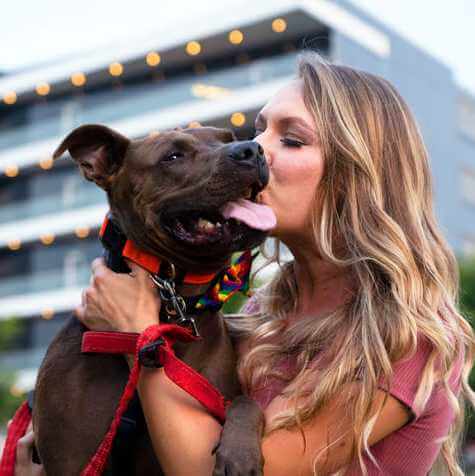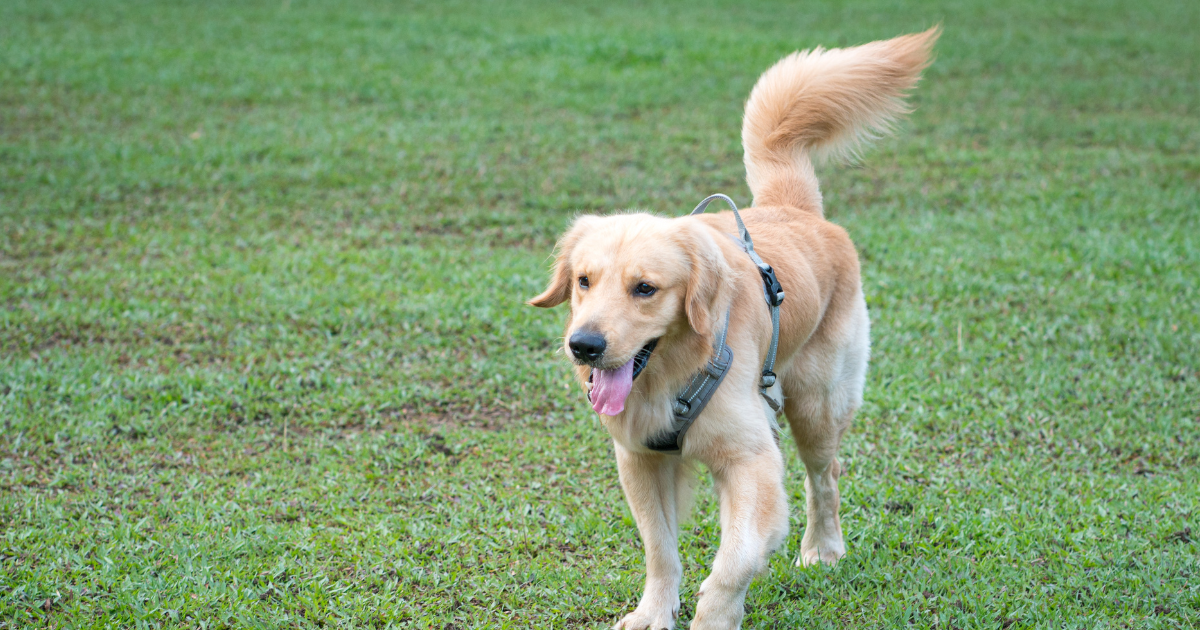"Aww! Look at that little tail go! What a happy little doggy!"
I’ve always associated tail wagging with a happy or excited dog. First, their whole body shakes with excitement. Next, their ears go up, and their eyes widen and brighten. Then, their tail starts moving rapidly, almost as if they are about to fly!
But did you know that dogs wag their tails for many reasons – not simply to indicate happiness, excitement, or even contentment? For example, it’s been found that puppies use their tails to communicate as early as a month old! So let’s take a little closer look at the science behind why our dogs wag their tails.
The Science Behind the Wagging Tail
Once a puppy reaches its first month of life, it develops the ability to interact with its family members. So, he watches for cues from his mother and siblings. He begins to learn to wag his tail to tell his siblings that he is done playing or his mom that he is hungry. Each is a slightly different way and, unless you’re paying attention, can be hard to differentiate as a casual observer.

Dogs have been bred for many generations to communicate and work with humans. As a result, they have developed various forms of body language tailored to their human counterparts. Tail-wagging is just one aspect of this.
Experts believe dogs use their tails to communicate everything from excitement to aggression, fear, and submission. A wagging tail might indicate a dog’s willingness to play or signal that a dog is feeling tense or nervous. A dog might even use its tail to “point” at something of interest, much like a human might use a finger.
Interestingly, tail wagging is not unique to dogs. Other animals, such as cats and horses, also use their tails to communicate. Some experts believe that tail wagging is similar to the “dance language” bees use to communicate with other hive members.
Understanding the nuances of tail wagging is important when interacting with dogs. As we mentioned, each type of wag can indicate a different emotion or intention, and it’s up to us as humans to learn how to interpret these signals. By paying attention to a dog’s tail (and overall body language), we can better communicate with our furry friends and provide them with the care and attention they need to be happy and healthy.
The Emotion Behind the Wagging Tail
So how can you accurately assess what emotion your dog is feeling? First, you need to establish a baseline unique to your dog’s breed and personality, as they will have a unique neutral or natural tail position. For example, most dogs have relaxed tails but breeds like Beagles hold their tail rigid and high, and Whippets naturally tuck their tail under.
Happy Tail
The faster the wag, the more excited or emotional the dog is. An incredibly rapid wag is known as flagging and is usually done with the tail in a neutral or slightly raised position. For example, a friendly dog will wag his tail more freely, maybe even adding a butt wiggle to it, while a dog that is unsure or insecure might wag his tail ever so slightly to indicate that he is insecure.
Alert Tail
The tail might also be tucked or lowered, indicating submission or that the dog is afraid. This lower tail position reduces the scent emitted from the anal glands, allowing the dog to “fly under the radar” and not attract additional attention from other dogs or animals.
A dog that wags his tail really fast while holding it straight up can indicate an active threat. The higher the tail, the greater the threat. Look for other body signs like stiffness and a direct stare. This stance can release a scent from the anal glands announcing the dog’s arrival and boldly marking his territory.
If you’re paying close attention, you can see when your dog transitions from a neutral stance to an alert one. When alert, dogs tend to stand with their ears and tails raised. This posture indicates they are watching and ready to confront whatever caught their attention.
Alternatively, a curious dog will have his tail straight out horizontally. You might also see them sniffing or trying to move in the direction of whatever they’ve taken note of.

The Human Best Friend Behind the Wagging Tail
Ultimately, if the dog in question is your trusted companion, you will have a good sixth sense of what they’re feeling or experiencing. When you’ve spent tons of time together, you can tell when they go from neutral to curious to scared or excited. The change in body language can be quick, but the more time you spend with your dog, the easier it will be for them to communicate with you.
As pet owners, we often develop a strong bond with our dogs and become attuned to their body language and behavioral cues. Over time, we learn to recognize when our dogs feel happy, relaxed, or nervous. This can be incredibly helpful in keeping our dogs safe and comfortable.
However, it’s important to be cautious and respectful when encountering an unfamiliar dog. A scared or nervous dog can be unpredictable, and their body language can be challenging to read. If a dog is exhibiting signs of fear or stress, it’s best to give them plenty of space and avoid making direct eye contact.
By learning about dog body language, we can better understand how our furry friends communicate with us. This allows us to provide them with the care and support they need while avoiding potentially dangerous situations. Whether interacting with your trusted companion or a new dog you’ve just met, always prioritize respect, kindness, and patience.
Conclusion
So, we’ve learned that it’s true that tail wagging is often associated with a happy or excited dog, and it’s one of the most recognizable doggy behaviors. However, as you’ve discovered, there are many reasons why a dog might wag its tail.
For example, a dog might wag its tail to indicate fear, nervousness, or aggression. The speed and direction of the wag and the position of the dog’s ears and body can all provide clues to the dog’s emotional state.
Interestingly, not all dogs wag their tails in the same way. For example, some dogs might wag their tails high and quickly, while others might wag them low and slowly. Additionally, some dogs might wag their tails to one side or the other rather than straight up and down.
Despite all these different potential meanings, I think most of us can agree that there’s something undeniably adorable about a happy little doggy with a wagging tail – regardless of the reason behind it!





